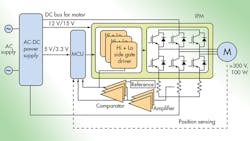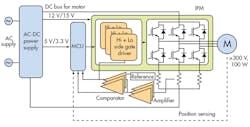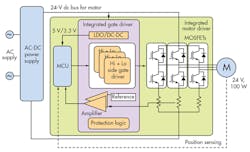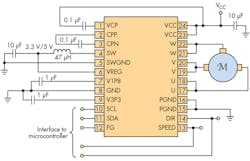Download this article in .PDF format
The home-appliance market is a large user of electric motors in both large systems (washers, dryers, refrigerators, HVAC, and dishwashers) and smaller units (mixers, vacuum cleaners, and fans). Many appliances contain multiple motors. A refrigerator, for example, uses motor-controlled dampers to distribute cold air, a water pump valve for the ice maker, one or more fan motors, and a compressor motor. An air-conditioning unit has an internal and external fan motor, a compressor motor, louver controls, perhaps even a motor for an automatic filter cleaner.
The Rise of BLDCs
Traditionally, designers employed ac induction motors in their designs. However, they're noisy, which is particularly undesirable for appliances installed inside the home.
Efficiency is another problem. Traditional induction motors have efficiencies as low as 35%, a real issue as governments worldwide implement regulations to boost energy efficiency.
Increasingly, appliance designs are switching to brushless dc motors (BLDCs). They offer high efficiency, lower audible noise, higher power density, a high degree of control, and long lifecycles. Compared to traditional ac induction motors, BLDCs require more complex electronic commutation.
Appliances are starting to include features such as user-programmable cycles and even Internet of Things (IoT) capability, though. Therefore, if the design already requires a microcontroller, adding a more complex BLDC control scheme is less of an incremental cost.
Other developments are also helping to reduce cost and complexity. Motor designers are taking cost out of the motors themselves by switching from copper to aluminum wires, for example, or replacing rare-earth magnets with cheaper ferrites. At the system level, BLDCs once required Hall sensors, encoders, or other feedback devices to accomplish electronic commutation, but newer designs are using sophisticated algorithms to eliminate the feedback sensors.
High-Voltage BLDC Designs
Many home appliances require high-power BLDC motors. Examples include washing machines, dryers, and HVAC compressors.
Figure 1 shows a standard BLDC-drive block diagram for a higher-power system. In this case, the ac-dc block generates a high-voltage dc bus, typically 150 or 300 V. This bus powers the inverter stage consisting of discrete MOSFETs, insulated-gate bipolar transistors (IGBTs), or an integrated power module (IPM).
The system requires additional power supplies: 5 or 3.3 V dc for the MCU, and 12 or 15 V for the gate drivers and feedback circuitry. Due to the high bus voltage, the integration options are limited: the IPM or power transistors must be packaged separately.
Low-Voltage BLDC Designs
A number of the motors used in appliances are100 W or less. These systems can benefit from a BLDC design, which provides the required power using a lower dc bus voltage such as 24 V (Fig. 2).
For smaller motors, a low-voltage solution has several advantages:
• High levels of integration: Several manufacturers offer highly integrated BLDC-motor driver ICs that include the closed-loop control algorithms in firmware—a host microcontroller downloads application-specific tuning parameters with a serial interface as part of system initialization. Other common features include linear or switching voltage regulators; operation amplifiers for shunt current sensing; integrated power transistors; and protection features such as overcurrent protection, overtemperature protection, stall detection, and auto dead-time insertion.
• Safety: Moving pumps and fans to a lower voltage limits system exposure to high voltages. The U.S. Occupational Safety and Health Administration (OSHA) considers all voltages above 50 V (ac or dc) to be hazardous, and safety agencies such as Underwriters Laboratories (UL) have specific requirements for designs that include high voltages. For example, minimum distances must be maintained between high voltages and other circuit elements, both on printed circuit boards (PCBs) and internally in components.
• Flexibility: A universal input ac-dc converter can allow use of the same low-voltage motors and drives for either 110- or 220-V line-input operation. The low-voltage motor drive subsystem is much easier to adapt to dc systems, such as battery- and solar-powered applications. A single motor and controller platform can apply to a wide variety of systems.
• Reduced size and cost: Low-voltage motor-control ICs usually are smaller in size than high-voltage power modules, which combine different technologies and must conform to rating agencies' safety requirements. In low-voltage low-power applications, power MOSFETs achieve very low FET losses, even taking the higher current into account. Then the power stage may not require extra thermal-management components (e.g., heat sinks) or increased thermal areas on the PCB, saving on overall system cost. Also, low-voltage bulk capacitors are smaller and cheaper than their high-voltage counterparts.
The DRV10983 (Fig. 3) is a good example of a device suitable for low-voltage BLDC applications. It's a three-phase sensorless motor driver with integrated power MOSFETs that can provide continuous drive current up to 2 A.
The device implements a proprietary control scheme, which eliminates the need for a Hall-effect or other sensor by continuously measuring the motor phase current, calculating the back EMF, and using that information to develop the timing signals. The result is a set of continuous sinusoidal drive signals that leads to significantly reduced acoustic noise.
An external device can control the BLDC directly through the SPEED pin, which accepts a PWM or analog input command, or via the I2C serial bus. Motor-speed feedback is provided through either the FG pin or I2C. The DRV10983 features an integrated regulator that steps down the supply voltage to either 5 or 3.3 V to power internal or external circuits. This regulator can be configured as either a switching buck regulator for highest efficiency or as a linear regulator for the lowest cost.
Two versions of the DRV10983 are available: the standby-mode version (3 mA) leaves the regulator running to power an external microcontroller; and the sleep-mode (180 µA) version shuts it off for minimum power consumption.
Low-Voltage BLDC Application: Dishwasher
Here's an example of an appliance design that uses the DRV10983. A modern dishwasher contains two motor-driven pumps: a circulation pump to circulate the clean water and a drain pump to remove the waste water. Although many dishwashers still use high-voltage (300 V) BLDC motors for these pumps, a low-voltage BLDC motor is an attractive option for the reasons discussed above.
The motor control block shown in Figure 4 is a dual-pump driver that delivers up to 130 W of continuous power output using a 24-V dc input voltage. When combined with a universal ac-dc power block, it forms a complete reference design.
The motor-control system includes different driver designs for the high-power (100 W) circulation pump and low-power (30 W) waste pump. The discrete implementation of the circulation pump drive gives the flexibility to scale the power level up or down as needed for the application.
In addition to the DRV10983, the other components of the motor-drive block are:
• Microcontroller: The MSP430G2544 is a low-power mixed-signal microcontroller with a 16-bit RISC core and 16 kB of NVRAM that runs at 16 MHz. Peripherals include 12 10-bit ADC channels, 32 GPIO pins, and SPI, UART, and SPI serial communications.
• Circulation -pump pre-driver: The DRV8303 provides three half-bridge drivers, each capable of driving two N-channel MOSFETs. It can source up to 1.7 A and sink 2.3-A gate-drive current with slew-rate control to reduce EMI and circuitry to prevent current shoot-through.
• Circulation-pump power driver: Three CSD88539ND dual N-channel power MOSFETs provide drive power for the BLDC phases. The CSD88539ND, which uses NexFET transistors, implements a third-generation macrocell power-MOSFET technology that offers low RDS(ON) and low parasitic capacitance, suiting it for high-frequency switching applications.
• Support devices include a TLV803S supervisory circuit for initialization and timing supervision; a TPD4S09 four-channel ESD protection device; an LMT84 temperature sensor; a CSD17304Q3 NexFET power MOSFET for input voltage reverse-polarity protection; and an ISO7421 dual-channel 1-Mb/s digital isolator for UART communication with external modules.
• Software: The MCU is programmed with TI's InstaSPIN-BLDC motor-control software for sensorless trapezoidal BLDC control. Unlike other sensorless software packages based on back-EMF zero-cross timing, InstaSPIN-BLDC monitors the motor flux to determine the appropriate time to commutate. This technique exhibits quick response to transient changes in speed. It also allows for more stable low-speed operation than the back-EMF method, which suffers from signal-to-noise degradation at low speeds.
Conclusion
Home-appliance designs are continually changing to incorporate more sophisticated electronic functions, and their motor systems are no exception. The regulatory push toward more energy-efficient appliances with improved EMC/EMI performance has already led to the replacement of ac induction motors by BLDC designs in many applications.
The next step is a move toward lower voltage operation, which offers improvements in safety, more precise control, and lower costs for both manufacturers and (hopefully!) consumers.
Looking for parts? Go to SourceESB.
About the Author
Paul Pickering
Paul Pickering has over 35 years of engineering and marketing experience, including stints in automotive electronics, precision analog, power semiconductors, flight simulation and robotics. Originally from the North-East of England, he has lived and worked in Europe, the US, and Japan. He has a B.Sc. (Hons) in Physics & Electronics from Royal Holloway College, University of London, and has done graduate work at Tulsa University. In his spare time, he plays and teaches the guitar in the Phoenix, Ariz. area




